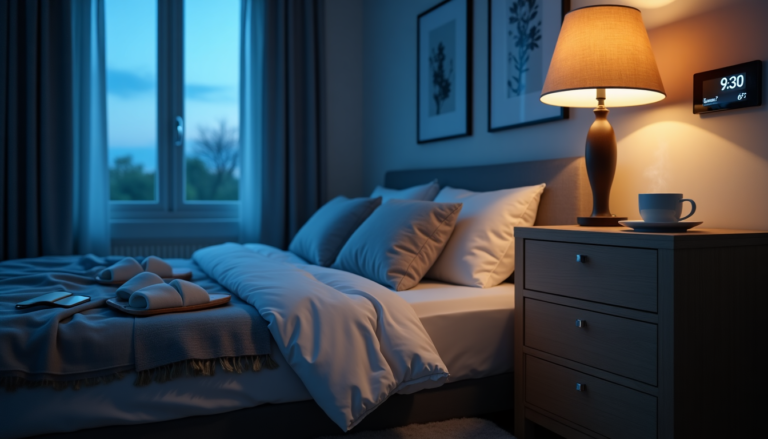Does Blue Light Damage Skin? The Hidden Truth Your Screen Won’t Tell You
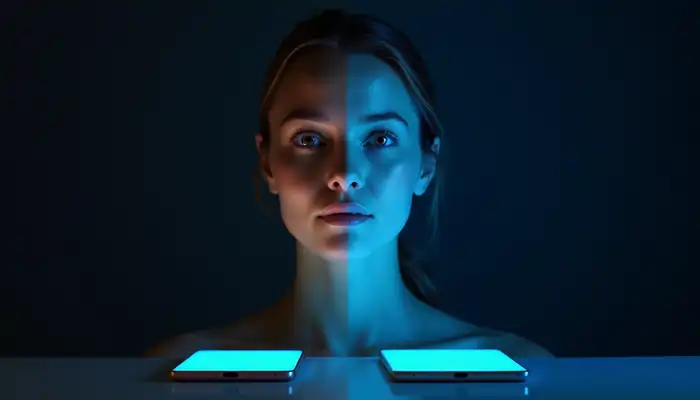
Most people protect their skin from UV rays, but another light source affects our skin health daily. Research about blue light damage reveals something concerning – blue light goes deeper into our skin than UV radiation and reaches the dermis.
Screen time takes a toll on our skin. The evidence shows that blue light exposure for just 60 minutes can cause cells to shrink and die. Extended exposure speeds up aging by breaking down collagen and increasing oxidative stress. The damage runs deep. Blue light changes our circadian rhythm and creates lasting hyperpigmentation, especially for people with darker skin tones.
Our detailed research explains how blue light affects skin and the steps needed to prevent damage. You’ll learn about the science behind skin damage and effective protection strategies to keep your skin safe in today’s digital world.
Understanding Blue Light and Its Skin Penetration
Light exists on a spectrum beyond what we can see, and it interacts with our skin in ways scientists are still discovering. My extensive research reveals the science behind blue light and its unique relationship with our body’s largest organ.
In this section:
- What is blue light and where it’s found
- How blue light penetrates deeper than UV rays
- Comparing natural vs. artificial blue light sources
What is blue light and where is it found?
Blue light exists as a high-energy visible (HEV) light within the wavelength range of 380-500 nanometers on the visible light spectrum [1]. Blue light stands out as the most energetic of visible lights, with higher energy per photon than other colors we can see [2].
Sunlight serves as the main source of blue light [1]. Digital devices now expose us to artificial blue light through computer screens, smartphones, tablets, LED TVs, and fluorescent lighting [1].
People’s habits have changed radically. Screen time has increased while outdoor time has decreased, which means our exposure now comes mainly from artificial sources [3].
How blue light penetrates deeper than UV rays
Blue light poses unique challenges to skin health because of its penetration power. UV rays get blocked by your eyes’ cornea and lens, but blue light passes right through these barriers [1].
Your skin faces an even bigger challenge – blue light reaches up to 1mm into the dermis [4]. This depth lets it affect cells and structures that UV radiation cannot reach.
Specialized molecules called chromophores enable this deep penetration. These light-absorbing molecules include flavins, porphyrins, nitrosated proteins, and opsins [4]. Blue light triggers various biological responses when it interacts with these chromophores, such as oxidative stress and inflammatory reactions [5].
The penetration zone of blue light sits between UV radiation and infrared – deeper than UV but more superficial than infrared [4]. This unique position creates effects unlike other types of light exposure.
Natural vs. artificial blue light sources
Natural and artificial blue light share the same wavelength range, but their intensity is very different. The sun produces blue light at about 7700 μW/cm², making it substantially more powerful than artificial sources [6]. A Philips LED television outputs only about 78 μW/cm², while a Dell laptop emits around 15 μW/cm² [6].
Sunlight’s blue light appears 100 to 1000 times stronger than electronic displays [7]. Our digital-focused lifestyle means we get constant exposure to artificial blue light, despite its lower intensity.
These sources differ beyond just intensity. Sunlight provides blue light alongside a balance of other wavelengths [2]. Artificial blue light lacks this balanced spectrum, which might cause different skin effects than natural exposure.
Solar blue light remains the main concern for skin damage, though total exposure from all sources needs to be thought over [7].
Authoritative Resources:
- National Eye Institute: https://www.nei.nih.gov/about/news-and-events/news/how-blue-light-affects-your-eyes-sleep-and-health
- The Journal of Clinical and Esthetic Dermatology: https://jcadonline.com/visible-light-skin/
The Science Behind Blue Light Skin Damage
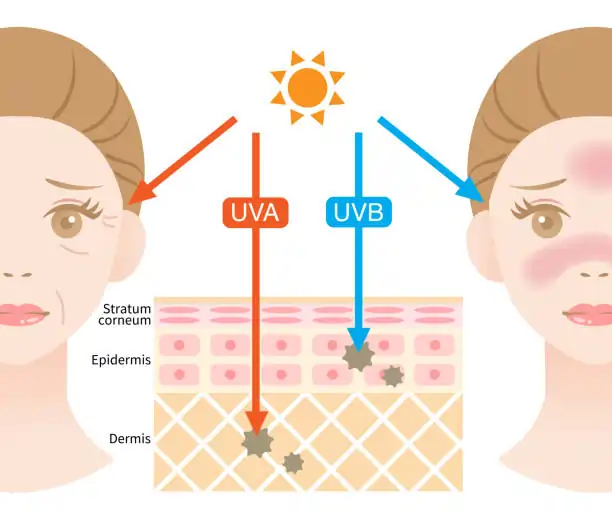
Image Source: iStock
Blue light sets off a chain of harmful reactions that hurt skin cells. Scientists now know that blue light damage isn’t just theoretical—it’s a proven fact that affects skin through multiple pathways.
In this section:
- Oxidative stress and free radical production
- DNA damage mechanisms
- Impact on cellular energy production
Oxidative stress and free radical production
Blue light starts damaging skin through photosensitization—light-absorbing molecules called chromophores get excited and trigger chemical reactions. When blue light hits your skin, it activates certain molecules that create reactive oxygen species (ROS).
Research shows nitric oxide (NO) and these reactive oxygen species are the two main molecules that control how cells respond to blue light [8]. Our skin cells contain these main photosensitizers that absorb blue light:
- Flavins (including FAD and FMN)
- Porphyrins (such as heme)
- Carbonylated proteins in the stratum corneum
These photosensitizers create several types of ROS once activated. You’ll find superoxide anions (O₂⁻), hydrogen peroxide (H₂O₂), hydroxyl radicals (•OH), and singlet oxygen (¹O₂) [9]. Scientists have found that superoxide is more likely to be the main ROS that blue light creates, rather than singlet oxygen [10].
These ROS molecules cause damage by:
- Lipid peroxidation (destroying cell membranes)
- Protein inactivation (damaging enzymes and structural proteins)
- DNA modifications (causing genetic mutations) [9]
Blue light causes oxidative stress in human keratinocytes and dermal fibroblasts, just like in UVA radiation [8]. The difference lies in efficiency—blue light generates ROS at about 25% of UVA’s rate in human keratinocytes [11].
DNA damage mechanisms
Blue light doesn’t just create oxidative stress—it directly harms cellular DNA. Scientists have proven that blue light causes DNA damage based on exposure levels in human keratinocytes. This includes oxidative lesions and cyclobutane-pyrimidine-dimer (CPD) DNA lesions [12].
Blue light targets mitochondrial DNA (mtDNA) especially hard. Research shows that light exposure damages mtDNA by a lot at 3 hours (0.7 lesions per 10 kb DNA) [13]. This happens because:
- Mitochondria have many blue light-absorbing chromophores
- mtDNA doesn’t have the protective histone proteins that nuclear DNA has
- mtDNA sits near the inner mitochondrial membrane where ROS form [14]
Blue light also shows clastogenic and aneugenic effects that lead to lasting, inheritable chromosome changes [3]. This genetic instability looks like some UV radiation effects and might speed up how skin ages.
Impact on cellular energy production
The biggest threat to skin health might be how blue light disrupts our cellular energy factories—mitochondria. Scientists have found that blue light reduces mitochondrial breathing activity [15], interferes with ATP production, and causes mitochondrial problems [3].
Everything starts when blue light chemically affects mitochondrial flavoproteins. This makes the electron transport chain less efficient, which means less adenosine triphosphate (ATP)—the energy our cells need to work properly [16].
Research specifically shows that blue light:
- Depolarizes mitochondrial membranes [1]
- Boosts caspase-3 activity (a cell death pathway) [1]
- Lowers expression of genes that control mitochondrial function (EGR1 and FOXO1) [3]
These changes last longer than you might think. Poor mitochondrial activity over time permanently damages skin cells, makes them age faster, and leaves them more vulnerable to environmental stress [16].
Authoritative Resources:
- Journal of Investigative Dermatology: https://www.jidonline.org/
- National Center for Biotechnology Information: https://www.ncbi.nlm.nih.gov/
- Journal of Photochemistry and Photobiology: https://www.journals.elsevier.com/journal-of-photochemistry-and-photobiology-b-biology
How Blue Light Accelerates Skin Aging

Image Source: Shutterstock
Our skin’s youthful look depends on healthy collagen and elastin fibers—proteins that blue light targets and breaks down. Research now gives us a clear answer to “does blue light damage skin?” The aging effects are undeniable.
In this section:
- Collagen breakdown pathways
- Matrix metalloproteinase activation
- Comparison with UV-induced aging
Collagen breakdown pathways
Blue light goes deeper into the skin than UV radiation. It reaches the dermis where collagen and elastin—proteins that give skin its structure and bounce—live [17]. This deep reach makes blue light especially damaging to skin’s youthful framework.
Research shows blue light directly reduces type I collagen production. It blocks the transforming growth factor-beta (TGF-β) signaling pathway [18]. TGF-β normally tells fibroblasts to make collagen. Blue light disrupts this process, so your skin makes less of these vital structural proteins.
Studies also show that long exposure to blue light creates oxidative stress in skin cells. This stress not only causes inflammation but also breaks down existing collagen and elastin [19].
Matrix metalloproteinase activation
The most important aging mechanism involves matrix metalloproteinases (MMPs)—enzymes that break down collagen and speed up aging. Blue light turns on these enzymes [20], which starts a destructive chain reaction.
Research has found that blue light exposure:
- Raises MMP1 production by activating the JNK/c-Jun pathway [18]
- Starts the EGFR/p70S6K pathway that further increases MMP levels [18]
- Stops new collagen production while destroying existing fibers [20]
These MMPs break down current collagen and block new collagen from forming. This prevents healing and speeds up visible aging [20]. Just 60 minutes of exposure can trigger these harmful changes [21].
Comparison with UV-induced aging
Scientists first focused on UV radiation as the main cause of photoaging. All the same, evidence shows blue light ages skin through similar but unique ways.
Blue light reduces collagen production through the TGF-β/Smad signaling pathway, just like UVA [5]. Studies show blue light can be more harmful since it goes deeper than UVB [7]. It reaches the collagen-rich dermis and causes more damage.
Studies of photon effectiveness show blue light has about 68% of UVA’s damaging power in mouse skin [11]. This effect matters more now with increased screen time and indoor lighting exposure.
UV radiation causes skin cancer risks, but blue light mainly speeds up aging processes. It breaks down collagen and damages elastin [7], which leads to fine lines, wrinkles, and loose skin without raising cancer risks.
Authoritative Resources:
- Journal of Investigative Dermatology: https://www.jidonline.org/
- National Institute on Aging: https://www.nia.nih.gov/
- American Academy of Dermatology: https://www.aad.org/
Blue Light and Hyperpigmentation Concerns
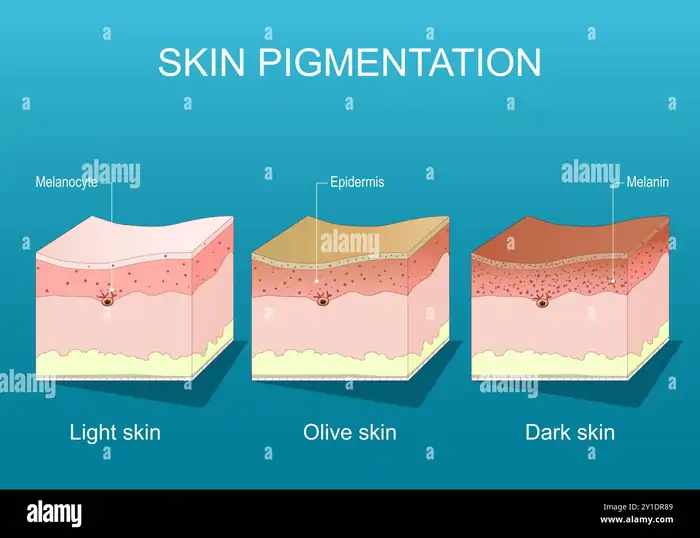
Image Source: Alamy
Your daily screen time, whether you’re scrolling through your phone or binge-watching shows, might leave more than just digital footprints—it could create visible marks on your skin. Recent research reveals a concerning aspect about the question: does blue light damage skin?
In this section:
- Melanocyte stimulation process
- Why darker skin types are more vulnerable
- Long-lasting pigmentation effects
Melanocyte stimulation process
Blue light exposure triggers visible skin darkening through a specialized protein called Opsin 3 (OPN3). This protein serves as the main sensor in melanocytes that detects and responds to blue light wavelengths [22]. OPN3 activation sets off a calcium-dependent signaling cascade that ends up increasing melanin production.
The process follows several precise steps:
- Blue light activates OPN3 in melanocytes
- Calcium influx activates CAMKII (calcium/calmodulin-dependent protein kinase II)
- CREB, ERK, and p38 pathways become activated
- MITF (microphthalmia-associated transcription factor) gets phosphorylated
- Production of melanogenesis enzymes—tyrosinase and dopachrome tautomerase (DCT)—increases [3]
Why darker skin types are more vulnerable
Without doubt, each skin type responds differently to blue light. People with darker skin (Fitzpatrick types III and higher) show more pronounced and persistent hyperpigmentation after blue light exposure [22]. Scientists attribute this vulnerability to “melano-competence”—the skin’s ability to produce substantial melanin when stimulated.
Darker-skinned individuals’ melanocytes form multimeric tyrosinase/DCT protein complexes [3]. These complexes maintain sustained tyrosinase activity, which explains why hyperpigmentation occurs mainly in skin types III and higher [23].
Long-lasting pigmentation effects
Blue light-induced hyperpigmentation’s persistence raises serious concerns. Studies show that blue light causes immediate darkening within just 20 minutes of exposure [23]. These effects can last three months—much longer than UV-induced pigmentation [2].
UV-induced pigmentation fades quickly, but blue light creates what researchers call “immediate, continuous, and delayed melanosis” [2]. This explains why people with conditions like melasma struggle with stubborn discoloration despite careful sun protection—their screens might continue to worsen the problem.
Authoritative Resources:
- Journal of Investigative Dermatology: https://www.jidonline.org/
- Frontiers in Physiology: https://www.frontiersin.org/journals/physiology
- National Center for Biotechnology Information: https://www.ncbi.nlm.nih.gov/
Effective Protection Strategies Against Blue Light
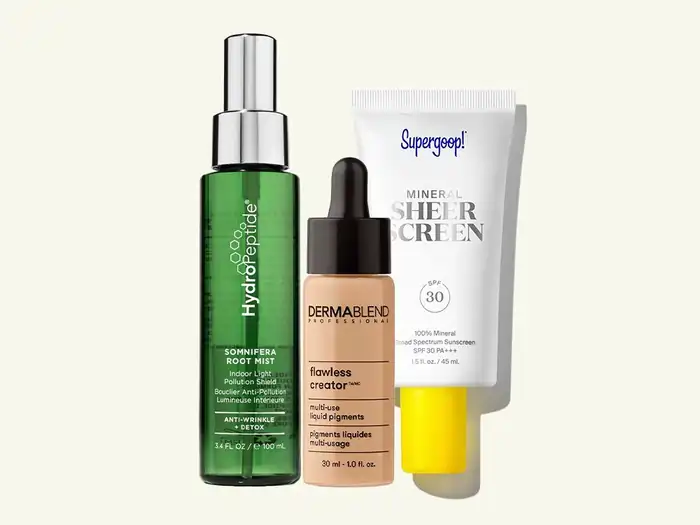
Image Source: NewBeauty
You don’t have to give up technology to protect your skin from blue light. A smarter approach to skincare and device usage will do the job. Let me share some science-backed strategies that will help you minimize blue light skin damage while keeping your digital lifestyle intact.
In this section:
- Antioxidant ingredients that work
- Physical blockers and specialized sunscreens
- Digital device settings and screen protectors
- Lifestyle adjustments for reduced exposure
Antioxidant ingredients that work
Your first line of defense against blue light effects on skin comes from antioxidants. They neutralize unstable molecules from free radical formation [24]. Vitamins C and E, niacinamide (vitamin B3), carotenoids, and plant extracts help fight oxidative stress from blue light exposure [25]. Your skin gets extra protection when you eat antioxidant-rich foods like leafy greens and blueberries [24].
Physical blockers and specialized sunscreens
Dermatologists recommend mineral sunscreens with zinc oxide or titanium dioxide because they reflect rays away from your skin [24]. Products with iron oxide work best against blue light aging. You’ll often find this ingredient in tinted formulations [26]. Yes, it is important to apply these physical blockers daily—even when you work indoors [25].
Digital device settings and screen protectors
The brightness of your screen should be reduced by up to 50% [24]. Dark mode or night shift settings can move your display to warmer colors at night [4]. Blue light screen protectors cut exposure by up to 45% and protect both your skin and eyes [6]. These filters create a barrier between your skin and the harmful light from screens [27].
Lifestyle adjustments for reduced exposure
The 20-20-20 rule works well: look at something 20 feet away for 20 seconds every 20 minutes [28]. Your skin needs a break from blue light hyperpigmentation, so stay away from screens 1-2 hours before bed [29]. Regular digital breaks give your skin time to recover from constant exposure [24].
Authoritative Resources:
- American Academy of Dermatology: https://www.aad.org/
- National Eye Institute: https://www.nei.nih.gov/
- Journal of Investigative Dermatology: https://www.jidonline.org/
Conclusion
Scientific research shows blue light goes deeper into skin than UV radiation and causes the most important damage in several ways. Just 60 minutes of exposure can trigger cell damage, and continuous exposure over time guides skin to age faster and develop stubborn dark spots.
Screens don’t emit blue light as intensely as the sun, but we spend so much time with them that they pose real risks. The findings raise serious concerns – blue light harms mitochondrial DNA and breaks down collagen, with effects that continue even after exposure stops.
You don’t need to give up technology to protect yourself. A few simple changes work well as barriers against blue light damage. Using mineral sunscreens with iron oxide, switching devices to dark mode, and applying skincare rich in antioxidants can help. These proven strategies let you keep your skin healthy while staying connected in the digital world.
Note that people with darker skin types face higher chances of lasting pigmentation from blue light. Your skin needs time to recover, so take regular breaks and keep some distance from your screens.
Authoritative Resources:
- Skin Cancer Foundation: https://www.skincancer.org
- American Academy of Dermatology: https://www.aad.org
- Journal of Investigative Dermatology: https://www.jidonline.org
FAQs
How does blue light affect skin aging?
Blue light penetrates deeper into the skin than UV rays, reaching the dermis where it breaks down collagen and elastin. This leads to premature aging by causing wrinkles, fine lines, and loss of skin elasticity. Blue light exposure also activates enzymes that further degrade collagen.
Is blue light from digital devices harmful to skin?
While digital devices emit less intense blue light than the sun, prolonged exposure from screens can still damage skin over time. Even 60 minutes of exposure can trigger cellular damage. The cumulative effects from constant screen use are a growing concern for skin health.
Are darker skin tones more vulnerable to blue light damage?
Yes, individuals with darker skin (Fitzpatrick types III and higher) are more susceptible to blue light-induced hyperpigmentation. This is due to their skin’s increased ability to produce melanin in response to stimuli. The pigmentation effects from blue light can also last longer in darker skin tones.
How can I protect my skin from blue light exposure?
Use mineral sunscreens with zinc oxide or titanium dioxide daily, even indoors. Look for products containing iron oxide for enhanced protection. Apply antioxidant-rich skincare products. Adjust device settings to lower brightness and enable night mode. Consider using blue light screen protectors on your devices.
Does blue light from screens cause more damage than UV rays?
While blue light penetrates deeper into the skin than UV rays, it primarily accelerates aging rather than causing DNA damage associated with skin cancer. However, blue light’s effects can be more persistent, with pigmentation lasting up to three months compared to UV-induced pigmentation. Both types of light can harm skin health in different ways.
References
[1] – https://pubmed.ncbi.nlm.nih.gov/36462794/
[2] – https://pmc.ncbi.nlm.nih.gov/articles/PMC10315449/
[3] – https://karger.com/spp/article/35/6/305/826941/Direct-and-Indirect-Effects-of-Blue-Light-Exposure
[4] – https://www.pcmag.com/how-to/how-to-stop-blue-light-from-disturbing-your-sleep
[5] – https://thedermdigest.com/blues-clues-research-explores-how-blue-light-affects-skin/
[6] – https://us.targus.com/collections/blue-light-filters?srsltid=AfmBOopDJEzFzPnmkY6FZ2nQG79ey84ROWI7WbuKUYXpNLZwMRujeQH5
[7] – https://www.yahoo.com/lifestyle/blue-light-linked-premature-aging-110033959.html
[8] – https://pubmed.ncbi.nlm.nih.gov/36594795/
[9] – https://pmc.ncbi.nlm.nih.gov/articles/PMC6721470/
[10] – https://pubmed.ncbi.nlm.nih.gov/28315451/
[11] – https://www.sciencedirect.com/science/article/abs/pii/S089158491730134X
[12] – https://pubmed.ncbi.nlm.nih.gov/34265135/
[13] – https://pubmed.ncbi.nlm.nih.gov/15797866/
[14] – https://www.jbc.org/article/S0021-9258(20)61544-7/fulltext
[15] – https://www.sciencedirect.com/science/article/pii/S0021925820615447
[16] – https://news.oregonstate.edu/news/harm-blue-light-exposure-increases-age-oregon-state-university-research-suggests
[17] – https://www.sanovadermatology.com/skin-care/how-blue-light-affects-your-skin/
[18] – https://www.sciencedirect.com/science/article/pii/S0923181123001500
[19] – https://thoclor.com/blue-light-and-skin-health/
[20] – https://onlinelibrary.wiley.com/doi/10.1111/jocd.15576
[21] – https://www.webmd.com/eye-health/blue-light-skin
[22] – https://www.researchgate.net/publication/319287257_Melanocytes_sense_blue_light_and_regulate_pigmentation_through_the_Opsin3
[23] – https://www.absolutejoi.com/blogs/skincare-for-you-1/blue-light-and-hyperpigmentation?srsltid=AfmBOorKalm4CtPTd6bE3WxBOukpqayyW70EzMT9h3fkwrfj29RxycSx
[24] – https://mdsolarsciences.com/blogs/news/blue-light-and-skin-damage-blue-light-effect-on-skin?srsltid=AfmBOorAHzcI5IN0FdyD8Khx_A5gW8UYiWPW53qK8AGZK0DHeKBCTdaH
[25] – https://mindbodywellnessmedspa.com/2023/08/02/blue-light-and-skin-damage-what-you-need-to-know/
[26] – https://www.instyle.com/beauty/skin/blue-light-effects-on-skin
[27] – https://eyejust.com/collections/products?srsltid=AfmBOopQLm4F_jR3jnjjhFKmeatATSypJvtIdGiJMuXQCWXkMpSQ2waN
[28] – https://www.hp.com/us-en/shop/tech-takes/reducing-blue-light-on-your-pc-screen
[29] – https://www.health.harvard.edu/staying-healthy/blue-light-has-a-dark-side






